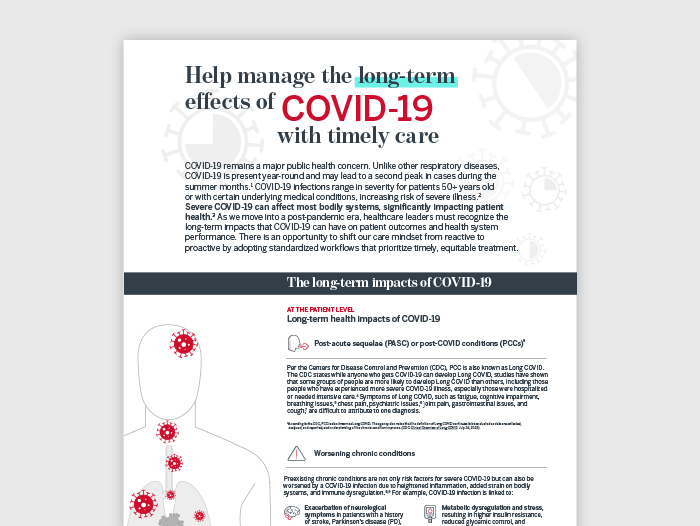Auto logout in seconds.
Continue LogoutCOVID-19 hospitalizations rose by roughly 16% for the week ending in Aug. 26, while COVID-19 deaths rose almost 18%, according to recent data from CDC. But experts say that overall numbers remain low, and a resurgence similar to previous years is unlikely.
Where hospitalizations are rising
According to CDC, there were 17,400 new COVID-19 hospitalizations for the week ending in Aug. 26, marking the seventh straight week that COVID-19 hospitalizations have risen. However, this is still less than half the number of admissions during the same period last year and one-fifth of the number in 2021.
Meanwhile, COVID-19 deaths in August have averaged around 600 per week, significantly lower than the 3,000 per week average from late August 2022 and the 14,000 per week average in late August 2021.
Overall, only two states — New Mexico and Vermont — saw a decrease in COVID-19 hospitalizations during the week ending in Aug. 26. Meanwhile, 35 states saw either a moderate or substantial increase in COVID-19 hospitalizations for the week ending in Aug. 26.
Peter Chin-Hong, a professor of medicine at the University of California, San Francisco, said that his hospital system has 21 patients hospitalized with COVID-19. Earlier this summer, his hospital system typically saw 10 to 15 patients. So while numbers have increased, Chin-Hong noted it's nothing like he saw last winter when more than 100 patients were hospitalized with COVID-19.
More older adults have also been hospitalized with COVID-19 in recent weeks, according to Humana.
"We have seen a further slight uptick in the inpatient side related to Covid," said Humana CFO Susan Diamond. "We did, within our estimates, assume that we would see an uptick in Covid, although we had assumed that it would occur in the fourth quarter."
According to CDC, the EG.5 omicron subvariant is the most common coronavirus variant, making up 21.5% of all cases occurring between Aug. 20 and Sep. 2, followed by FL.1.5.1, which made up 14.5%, XBB.1.16.6, which made up 9.2%, and XBB.1.16, which made up 8.9%.
CDC has also noted a rise in cases of respiratory syncytial virus (RSV) cases among young children in Florida and Georgia.
Between Aug. 5 and Aug. 19, the rate of hospitalizations related to RSV increased from 2 in 100,000 children ages 4 and younger to 7 per 100,000, with the majority of those hospitalizations occurring in babies less than a year old, CDC said.
Experts say COVID-19 won't be as bad as previous years
Gigi Gronvall, a biosecurity expert at the Johns Hopkins Center for Health Security, noted that while COVID-19 rates are rising, the overall numbers remain low.
"These increases are more alarming by statistics than in reality," Gronvall said.
"What I think we're seeing is the virus continuing to evolve, and then leading to waves of infection, hopefully mostly mild in severity," said Dan Barouch, head of the Center for Virology and Vaccine Research at Beth Israel Deaconess Medical Center.
Andrew Read, an evolutionary microbiologist at Pennsylvania State University, said there's nothing alarming or unexpected about the coronavirus continuing to mutate.
"When a mutation confers an interesting new trick that's got an advantage, it's going to be popping up in many different places," Read said. "Everything we see is just consistent with how you imagine virus evolution proceeding in a situation where a new virus has jumped into a novel host population." (Mandavilli, New York Times, 9/7; Miller et. al., NBC News, 9/5; Herman, STAT, 9/6; Edwards, NBC News, 9/5; Frank, Axios, 9/5)
Going into the fall, the United States may see a new surge of respiratory viruses, including COVID-19, respiratory syncytial virus (RSV), and influenza. To protect against illness, federal health officials are encouraging people to get vaccinated once new shots against these three viruses are available.
Don't miss out on the latest Advisory Board insights
Create your free account to access 1 resource, including the latest research and webinars.
Want access without creating an account?
You have 1 free members-only resource remaining this month.
1 free members-only resources remaining
1 free members-only resources remaining
You've reached your limit of free insights
Become a member to access all of Advisory Board's resources, events, and experts
Never miss out on the latest innovative health care content tailored to you.
Benefits include:
You've reached your limit of free insights
Become a member to access all of Advisory Board's resources, events, and experts
Never miss out on the latest innovative health care content tailored to you.
Benefits include:
This content is available through your Curated Research partnership with Advisory Board. Click on ‘view this resource’ to read the full piece
Email ask@advisory.com to learn more
Click on ‘Become a Member’ to learn about the benefits of a Full-Access partnership with Advisory Board
Never miss out on the latest innovative health care content tailored to you.
Benefits Include:
This is for members only. Learn more.
Click on ‘Become a Member’ to learn about the benefits of a Full-Access partnership with Advisory Board
Never miss out on the latest innovative health care content tailored to you.

